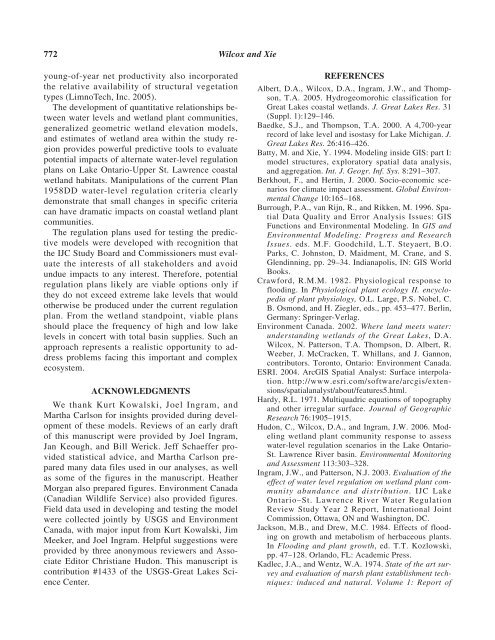Predicting Wetland Plant Community Responses to ... - BioOne
Predicting Wetland Plant Community Responses to ... - BioOne
Predicting Wetland Plant Community Responses to ... - BioOne
You also want an ePaper? Increase the reach of your titles
YUMPU automatically turns print PDFs into web optimized ePapers that Google loves.
772 Wilcox and Xie<br />
young-of-year net productivity also incorporated<br />
the relative availability of structural vegetation<br />
types (LimnoTech, Inc. 2005).<br />
The development of quantitative relationships between<br />
water levels and wetland plant communities,<br />
generalized geometric wetland elevation models,<br />
and estimates of wetland area within the study region<br />
provides powerful predictive <strong>to</strong>ols <strong>to</strong> evaluate<br />
potential impacts of alternate water-level regulation<br />
plans on Lake Ontario-Upper St. Lawrence coastal<br />
wetland habitats. Manipulations of the current Plan<br />
1958DD water-level regulation criteria clearly<br />
demonstrate that small changes in specific criteria<br />
can have dramatic impacts on coastal wetland plant<br />
communities.<br />
The regulation plans used for testing the predictive<br />
models were developed with recognition that<br />
the IJC Study Board and Commissioners must evaluate<br />
the interests of all stakeholders and avoid<br />
undue impacts <strong>to</strong> any interest. Therefore, potential<br />
regulation plans likely are viable options only if<br />
they do not exceed extreme lake levels that would<br />
otherwise be produced under the current regulation<br />
plan. From the wetland standpoint, viable plans<br />
should place the frequency of high and low lake<br />
levels in concert with <strong>to</strong>tal basin supplies. Such an<br />
approach represents a realistic opportunity <strong>to</strong> address<br />
problems facing this important and complex<br />
ecosystem.<br />
ACKNOWLEDGMENTS<br />
We thank Kurt Kowalski, Joel Ingram, and<br />
Martha Carlson for insights provided during development<br />
of these models. Reviews of an early draft<br />
of this manuscript were provided by Joel Ingram,<br />
Jan Keough, and Bill Werick. Jeff Schaeffer provided<br />
statistical advice, and Martha Carlson prepared<br />
many data files used in our analyses, as well<br />
as some of the figures in the manuscript. Heather<br />
Morgan also prepared figures. Environment Canada<br />
(Canadian Wildlife Service) also provided figures.<br />
Field data used in developing and testing the model<br />
were collected jointly by USGS and Environment<br />
Canada, with major input from Kurt Kowalski, Jim<br />
Meeker, and Joel Ingram. Helpful suggestions were<br />
provided by three anonymous reviewers and Associate<br />
Edi<strong>to</strong>r Christiane Hudon. This manuscript is<br />
contribution #1433 of the USGS-Great Lakes Science<br />
Center.<br />
REFERENCES<br />
Albert, D.A., Wilcox, D.A., Ingram, J.W., and Thompson,<br />
T.A. 2005. Hydrogeomorohic classification for<br />
Great Lakes coastal wetlands. J. Great Lakes Res. 31<br />
(Suppl. 1):129–146.<br />
Baedke, S.J., and Thompson, T.A. 2000. A 4,700-year<br />
record of lake level and isostasy for Lake Michigan. J.<br />
Great Lakes Res. 26:416–426.<br />
Batty, M. and Xie, Y. 1994. Modeling inside GIS: part I:<br />
model structures, explora<strong>to</strong>ry spatial data analysis,<br />
and aggregation. Int. J. Geogr. Inf. Sys. 8:291–307.<br />
Berkhout, F., and Hertin, J. 2000. Socio-economic scenarios<br />
for climate impact assessment. Global Environmental<br />
Change 10:165–168.<br />
Burrough, P.A., van Rijn, R., and Rikken, M. 1996. Spatial<br />
Data Quality and Error Analysis Issues: GIS<br />
Functions and Environmental Modeling. In GIS and<br />
Environmental Modeling: Progress and Research<br />
Issues. eds. M.F. Goodchild, L.T. Steyaert, B.O.<br />
Parks, C. Johns<strong>to</strong>n, D. Maidment, M. Crane, and S.<br />
Glendinning, pp. 29–34. Indianapolis, IN: GIS World<br />
Books.<br />
Crawford, R.M.M. 1982. Physiological response <strong>to</strong><br />
flooding. In Physiological plant ecology II. encyclopedia<br />
of plant physiology, O.L. Large, P.S. Nobel, C.<br />
B. Osmond, and H. Ziegler, eds., pp. 453–477. Berlin,<br />
Germany: Springer-Verlag.<br />
Environment Canada. 2002. Where land meets water:<br />
understanding wetlands of the Great Lakes, D.A.<br />
Wilcox, N. Patterson, T.A. Thompson, D. Albert, R.<br />
Weeber, J. McCracken, T. Whillans, and J. Gannon,<br />
contribu<strong>to</strong>rs. Toron<strong>to</strong>, Ontario: Environment Canada.<br />
ESRI. 2004. ArcGIS Spatial Analyst: Surface interpolation.<br />
http://www.esri.com/software/arcgis/extensions/spatialanalyst/about/features5.html.<br />
Hardy, R.L. 1971. Multiquadric equations of <strong>to</strong>pography<br />
and other irregular surface. Journal of Geographic<br />
Research 76:1905–1915.<br />
Hudon, C., Wilcox, D.A., and Ingram, J.W. 2006. Modeling<br />
wetland plant community response <strong>to</strong> assess<br />
water-level regulation scenarios in the Lake Ontario-<br />
St. Lawrence River basin. Environmental Moni<strong>to</strong>ring<br />
and Assessment 113:303–328.<br />
Ingram, J.W., and Patterson, N.J. 2003. Evaluation of the<br />
effect of water level regulation on wetland plant community<br />
abundance and distribution. IJC Lake<br />
Ontario–St. Lawrence River Water Regulation<br />
Review Study Year 2 Report, International Joint<br />
Commission, Ottawa, ON and Washing<strong>to</strong>n, DC.<br />
Jackson, M.B., and Drew, M.C. 1984. Effects of flooding<br />
on growth and metabolism of herbaceous plants.<br />
In Flooding and plant growth, ed. T.T. Kozlowski,<br />
pp. 47–128. Orlando, FL: Academic Press.<br />
Kadlec, J.A., and Wentz, W.A. 1974. State of the art survey<br />
and evaluation of marsh plant establishment techniques:<br />
induced and natural. Volume 1: Report of
















